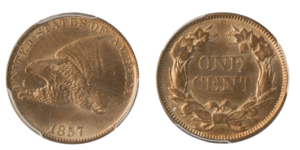Copper Shortage Paves Way for Small Flying Eagle Cent
Posted onThe Flying Eagle Cent, a perennially popular coin among collectors, has its origins in a copper shortage in the U.S. in the 1850s.
While copper has a rich history and was first used in coins around 8000 B.C.—in the United States in the 1850s—copper mining had yet to reach its heyday.
Compare these numbers for perspective. In 1845, copper production totaled a mere 13 tons in Michigan (the largest copper producer in America at the time). That number jumped to 7,170 tons in Michigan twenty years later!
So, in the 1850s, U.S. Mint officials reported difficulty breaking even while making large cent copper coins, as the price for the raw metal was climbing fast.
What’s more, Americans just didn’t like the large copper cents. People complained they were ugly, heavy and collected dirt easily.
The Passing of the Torch from the Large Cent to the Small Cent
A solution was put forward. The Treasury had been experimenting with a new small cent pattern coin in 1856. The small cent was about half the weight of the large cent, which would significantly reduce the Mint’s production costs.
While large cents weighed in at 10.89 grams, the new Flying Eagle pattern coin struck in 1856 clocked in at significantly lower 4.67 grams and was made from 88% copper and 12% nickel.
Congress and the Public Embraced the Flying Eagle Cent
Mint officials distributed the 1856 Flying Eagle cent pattern coin to Treasury officials, members of Congress and other VIPs as they considered the legislation. Additional 1856 proof pieces were struck for collectors and the early coins were snapped up quickly. While 2,000 pattern coins were minted in 1856, today survivors are extremely rare and highly desirable.
Since the coin met the approval of Congressional members, the Act of February 21, 1857 created official authorization for a new small cent made from a mixture of copper and nickel.
The same 1857 law created a provision where Americans could turn in their older cents, and also Spanish or Mexican coins that were commonly used in commerce at that time, for the new small cent.
When the Mint began official distribution of the Flying Eagle Cent in May 1857, long lines formed at the Mint as people wanted to trade in their old coins for the shiny new smaller cent.
Today, we consider Flying Eagle to be copper coins, but at their launch they were lovingly called “nicks” in reference to their nickel content. While the public clamored for these coins and adoption was swift, the Flying Eagle was only minted until 1858. Today, it is believed that striking problems were occurring with the high-relief on the design. The Indian Head cent replaced the Flying Eagle in 1859.
Mint Chief Engraver James Barton Longacre Designed This Delightful Coin
The obverse features a left-facing eagle with its wings outstretched in flight. Around the top, UNITED STATES OF AMERICA encircles the top two-thirds of the coin, with the date at bottom. The image of the eagle was influenced by work from Longacre’s predecessor, Christian Gobrecht. On the reverse, a detailed wreath comprised of leaves, corn seed heads, wheat, cotton and tobacco is wrapped in a ribbon. Centered on the reverse are the words ONE CENT. All coins were minted at Philadelphia and so there are no mint marks on the coins.
Collecting Flying Eagle Cents
The exciting history, arresting design and its stature as the first small cent make Flying Eagle Cents a highly collected series. Collectors typically want to acquire the 1856 pattern and the 1857 and 1858 coins. Additionally, there are three varieties in the series and collectors typically try to obtain all of them including the 1858 Double Die Obverse (1858/7), 1858 Large Letters and 1858 Small Letters. Are you intrigued? See this beautiful coin here.
Want to read more? Subscribe to the Blanchard Newsletter and get our tales from the vault, our favorite stories from around the world and the latest tangible assets news delivered to your inbox weekly.








